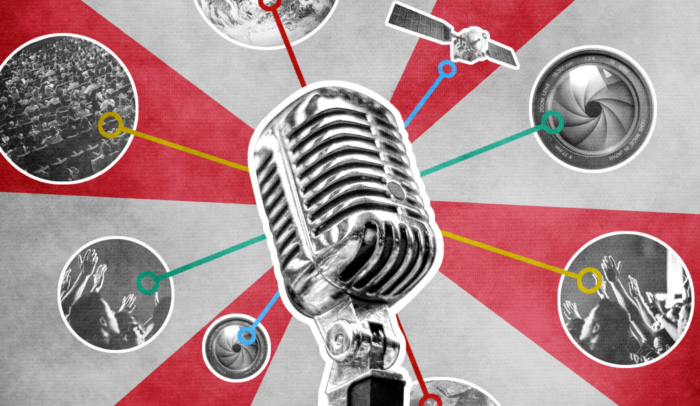Turning your book into a speech can be one of the best ways to get your message out there.
With the recent expansion of virtual conferences, TEDx venues, and streaming video, now’s the perfect time to turn your book into spoken content—whether for a single presentation or a video series.
But where do you start? How can you turn your book into a speech that’s really good?
This post will tell you everything you need to know about how to turn your book into an engaging speech that will hook an audience, hold their attention, and get them talking.
Choosing Your Topic
1. Who’s your audience?
The first key to a great speech is choosing the right topic. And finding the right thing to talk about starts with your audience.
Who are you writing the speech for? Who are you presenting it to?
If you’re presenting your speech to a specific group of people, they might make up just one section of your target audience. Or they might be your perfect target audience—but they might be attending this particular event for a specific reason.
Think about who they are and why they’re there.
2. Where are you giving the speech?
If you’re giving a speech at an association event or at a conference, think about the purpose behind the gathering.
What’s the theme of the event or the purpose behind the association? Make sure your speech fits the reason behind why the audience is gathering.
The event, as well as the environment in which the speech will be given, should also dictate the kind of speech you write and how deeply you involve the audience.
You always want your speech to be engaging, but in some virtual speech environments, you might not be able to see or hear your audience.
Make sure you think about the venue when deciding whether or not to include audience participation, as well as in planning the overall tone of your speech.
Whether your speech is thought-provoking and profound or high-energy and rousing should depend on both your audience and the event.
3. What has resonated with your audience?
Once you’re clear on your audience and venue, think about the parts of your book that tend to resonate the most with people.
The more people read your book, the more you’ll get a feel for the pieces that struck the most memorable chords.
People will comment on a specific anecdote from the book, or they’ll talk about how a certain idea opened up a new world for them.
Pay attention to any patterns that start to appear in those comments. Is there one story everyone seems to remember? Or one core idea that changed their perspective?
Take your book’s most compelling ideas and develop specific content around them that targets your speech’s audience and event.
4. Is there something big in popular culture or current events that relates?
People love timely content. They always enjoy hearing about things that relate to other things they’re caught up in.
What shows are popular right now? What time of year is it? What’s happening in the world? The more you can make your speech relate to current events or trending topics, the more people will tune in.
For example, when Game of Thrones was at its height, Will Leach wrote a series of posts on how you can use the HBO blockbuster show to understand mindstate marketing.
Not only were the posts a huge hit, they got Will an invitation to give a speech on the same topic at Merck.
5. How are you providing value?
Finally, what problem are you solving for your audience?
This relates back to your book’s positioning and why you wrote your book in the first place.

Remember, the goal isn’t just to get people to like your speech. It’s to get them to tell other people about it. To use those new ideas often enough that you stay front of mind.
So hook your audience with something spicy, like a popular TV show or a jarring premise. Then draw them in deeper by providing value. That’s the winning combination that gets people talking.
Writing Your Speech
1. Hook them from the start
Okay, so how do you hook an audience?
One way is to use a popular show, like the Game of Thrones example. But there are a million ways to grab people’s attention. For example, you can:
- Ask a fun question
- Ask a thought-provoking question
- Make a surprising statement
- Offer a counter-intuitive fact
Whatever direction you pick, the key is to make it surprising and unusual―and put that surprising and unusual fact or statement right in the title.
Here’s another example:
- “What working with psychopaths taught me about leadership”
Nashater Deu Solheim’s fascinating (and well-titled) TEDx speech already has over 400,000 views on YouTube.
Instead of using current events, Nashater developed an “evergreen” speech that draws people in with the perfect combination of the surprising and unusual.
It’s unusual because very few people work with psychopaths. It’s surprising because the last thing you’d expect that work to lead to is insight into leadership.
2. Make it personal
Even if you don’t have anything quite that unusual in your background, everyone has the potential for surprise and uniqueness. How? By speaking candidly about their own lives—especially when it comes to things people don’t usually talk about.
The more candid and authentic you’re willing to be, the more your message will draw people in and resonate with those who need it.
You can choose a profoundly authentic moment or anecdote from your book. Or you can choose a different anecdote from your own life and relate it to your book’s main concepts.
Remember, you don’t have to literally turn your book into a speech. As long as your speech is grounded in the main ideas of your book and illustrates the same concepts, you can use just about anything as the hook to engage your audience.
3. Write for the time you have
If your speech needs to last a significant amount of time, you might want to go through your book’s table of contents and use it as the general outline of your speech.
Go through each main idea and distill it into a quick few minutes, presenting it within the context of your theme’s hook.
Don’t feel like you have to use every single idea. If some fit better than others, focus on those. But you can use your table of contents to organize your speech’s structure.
If your time is limited, one quick idea from your book might be better. Tell one or two stories that illustrate your concept, and make sure you provide value to your audience by leaving them with a key takeaway they can use in their own lives.
Whatever you do, don’t lose sight of your audience. Whether you’re giving a long speech or a short one, focus on what’s relevant to this specific audience.
4. Read your speech out loud
Once your speech is drafted, read it out loud. If you’re going to be on video, record yourself giving the speech. Try to use the same frame you’ll use for the real speech.
For example, if you’re giving a TEDx talk on a stage, your recording should capture your whole body (because some TEDx frames will be that wide). If you’ll be in a Zoom conference, record yourself in a private Zoom meeting using the camera angle you expect to use.
Watch your recording, and check for:
- A good pace and tone
- Confident body language
- Eliminating negative habits (smacking your lips, saying um, etc.)
Do it again and again until you feel like you could do it in your sleep—and until you’re comfortable enough to look and sound like you’re talking to a friend.
When you see great speakers who sound casual and “off-the-cuff,” understand that they worked very hard to sound that way in front of an audience. So don’t skip the hard work.
Stage presence isn’t entirely natural for anyone. It’s a learned skill. But if you record yourself over and over, giving yourself notes each time and doing it again, your final presentation will look as though it was no effort at all.


